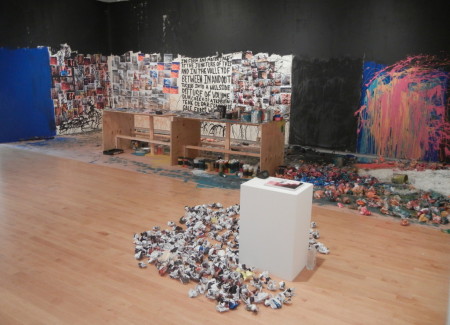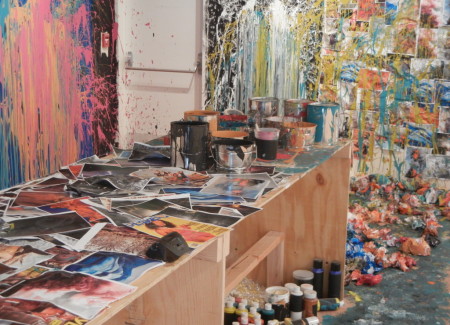JTF (just the facts): A total of 2 large scale color photographs, a 40 image slideshow, and an installation including 3 video screens and an array of imagery glued/painted on the walls, displayed in the entry area and a series of three rooms on the second floor of the museum. The 2 photographs are color prints from the Untitled (Cape) series, framed in black and unmatted, and made in 2009; the prints are sized 39×50 and 60×75 respectively, and no edition size information was made available. The 40 image slide show Into the Rehearsal (both color and black and white images) is shown in a small darkened room, visible only via a small rectangular hole in the locked door; it was made in 2013.
The main gallery space consists of the remnants of a 5 hour performance (Number 17) by the artist on the opening day of the exhibit. Printed imagery has been glued to the walls and covered with paint, feathers, plaster and other materials; a long wooden table in the center of the gallery holds the left over raw materials. Three video screens replay the activities of the three performers: installing/painting, improvisational sound/singing, and sequentially showing imagery and subsequently crumpling it up, with the intermixing of visitors watching. The work was made in 2013.
Comments/Context: The definition of what it means to be a contemporary photographer is more fluid today than at any time in the history of the medium. While it is still possible to craft a career in the traditional, behind the camera manner, more and more artists are using photography as just one of many tools in the toolbox, mixing photographic imagery with the output of other disciplines, in search of new ways of communicating their ideas. Xaviera Simmons was trained as a photographer (she studied just up the road at Bard), but her show at the Aldrich reaches in multiple directions beyond the rigidly photographic, bringing music, performance, installation, and expressionistic painting into interaction with different varieties of photographic imagery. The result is a loosely connected series of works that form a non-linear kind of narrative, ideas cycling back on themselves in alternating media.
Simmons’ two standard photographs combine cultural image appropriation and performance into layered portraits. Her subjects stand in the midst of beach and waterscapes, holding record albums over their faces, enlisting Grace Jones and Stephanie Mills as unexpected stand ins. The reversals are elegantly simple, but the images connect nuances of pop culture trends, music, personal aspiration, and cultural role models together with one deft replacement.
Simmons’ slide show of grainy Jamaican dancehall stills is evidence that her photographic interests extend beyond her own camera work to the modern practice of sifting found/Internet sourced imagery. Her series of fuzzy snapshots captures the current trend of “daggering”, an explicitly sexual, grinding dance where men and women smash together with frisky, jolting roughness. Seen through the tiny hole in the door, the images flip along in a silent rhythm (even though they are clearly musical); the way they are displayed, she’s exposed us a new wave of cultural remixing and made us feel like illicit voyeurs, the performing going on both on the screen and in the gallery, forcing us to examine our own limits and cultural preconceptions.
The work in the main gallery space is less overtly photographic (although it contains some photographic imagery), and given it depicts the aftermath of a performance and not the performance itself, it’s a little harder to parse. Half of the gallery is covered in a gestural collage of printed images, overpainted with splashes of color and decorated with other materials. Nudes from Players magazine (more cultural touchstones) are juxtaposed with monochrome landscapes and images of animals, different areas of the gallery put together in discrete sections. Three video screens show the action as it happened, from the active creation of the collaged frieze on one side, to the wailing, often atonal, voice of a sound improviser and a more stoic player displaying a single printed image (the same ones going up as part of the wall collage) and then crumpling it up and discarding it on the floor (the pile is what we see now) on the other. Clearly, these three activities were carefully woven together, but it’s a difficult to reassemble the feeling of being there the first time from the videos. What does come through is a sense of experimentation with and combination of artistic modes, and of doing so over a long enough period that endurance and chance become a factor. The avant-garde vocals are particularly sharp and jarring, bring an unsettling, uncertain edge to the proceedings.
While the diversity of artistic ideas on view here is impressive, Simmons has woven enough common themes through the works to keep them conceptually interlocked. The show is an example of photography as an initial starting point for further artistic improvisation, where one visual idea has morphed into another, each one building toward something more intricately layered and complex.
Collector’s POV: As this is a museum show, there are of course no posted prices. Simmons is represented by David Castillo Gallery in Miami (here). Her photographic work has little secondary market history, so gallery retail is likely the best option for those collectors interested in following up.










